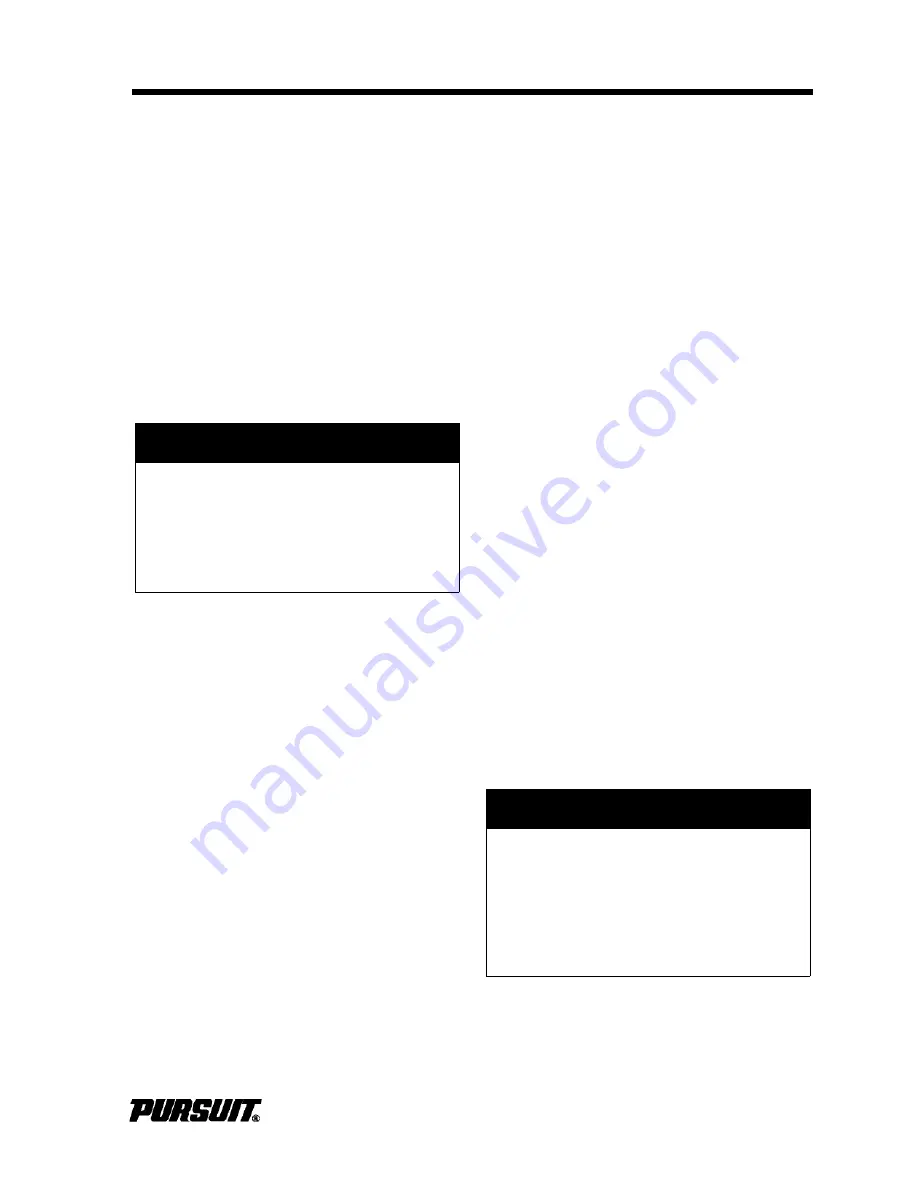
Interior Equipment
8-1
Section 8
OS 385
Interior Equipment
8.1 Companionway Door
The cabin is accessed through a sliding
door. Behind the companionway door is a
screen door. Lockable latches secure the
doors in the closed position. A vinyl covered
latch secures the doors in the open position.
DO NOT leave the door unlatched. Latch it
in the full “OPEN” or full “CLOSED” position.
The doors are made of acrylic plastic. Acrylic
plastic scratches easily and can chip. Refer
to Routine Maintenance for information
regarding proper care of acrylic plastic.
8.2 Mid-Berth
The mid-berth is located behind the steps.
There are hatches below the berth to pro-
vide access to the fresh water tank, fresh
water pump and forward bilge pump.
Remove the starboard wall panel to access
the head holding tank system and the refrig-
eration control unit. The battery chargers,
stereo amp, relay for the windlass, power
supply for the TV antenna, satellite radio
receiver and Fireboy® module are located
under the mid-berth settee. Do not use this
area for storage.
8.3 Head Compartment
The head compartment is equipped with a
tempered glass sink and a shower. The
shower door is acylic. For care and cleaning
information of the sink and shower door,
refer to Routine Maintenance Section.
Secure door in closed position whenever the
boat is underway to prevent damage to the
door.
An opening port light above the sink pro-
vides daylight and ventilation. An AC G.F.I.
duplex outlet is also provided.
Marine Head System
Your boat is equipped with a VacuFlush®
marine head system as standard equipment.
This system uses a small amount of water
and vacuum, which is generated by the 12-
volt vacuum pump to flush. The toilet is con-
nected to the pressurized fresh water sys-
tem. Fresh water is used to reduce odor in
the head compartment.
To use the toilet, make sure the “VacuFlush”
breaker on the MDP is on; lift the foot flush
lever slightly to wet the bowl with the desired
water level. Depress the flush lever all the
way for approximately three seconds or until
the bowl is clear. A sharp popping noise is
normal when the vacuum seal is broken and
flushing action begins. It is also normal for a
small amount of water to remain in the bowl
after flushing.
The waste is directed to the holding tank
until it is pumped out by a waste dumping
station or the overboard macerator dis-
charge system. The waste moves through a
one-inch opening in the toilet base. Incom-
ing air fragments mix with the waste as it
passes through the base opening. This pro-
cess eliminates the need for macerators or
mechanical motors in the toilet base. When
the tank is full, the tank monitor will show full
and the vacuum pump will not run.
The vacuum generator is mounted on the
holding tank and contains stored vacuum.
System vacuum is monitored by a vacuum
switch, which is located on the vacuum gen-
!
CAUTION
Keep the cabin door latched in the
open or closed position. The door is
heavy and slides easily. If the door is
unlatched, it could slide unexpectedly
as the boat rocks, causing injury or
damage.
!
NOTICE
DO NOT operate the macerator dry;
damage to the pump can occur.
In some waters it is illegal to dis-
charge waste overboard. Remove the
seacock handle or use another
method to prevent accidental dis-
charge.
Summary of Contents for OS 345
Page 2: ......
Page 4: ...Operator Notes OS 375...
Page 16: ...12 Operator Notes OS 385...
Page 32: ...3 6 Operator Notes OS 385...
Page 34: ...4 2 Section 4 Electrical System OS 385 Main Distribution Panel MDP...
Page 54: ...5 8 Operator Notes OS 385...
Page 56: ...6 2 Operator Notes OS 385...
Page 98: ...12 6 Operator Notes OS 385...
Page 104: ...A 6 Operator Notes OS 385...
Page 106: ...B 2 Appendix B Maintenance Log OS 385 Date Hours Dealer Service Repairs Maintenance Log...
Page 107: ...Maintenance Log B 3 Appendix B OS 385 Date Hours Dealer Service Repairs...
Page 108: ...B 4 Appendix B Maintenance Log OS 385 Date Hours Dealer Service Repairs...
Page 109: ...Boating Accident Report C 1 Appendix C OS 385 Boating Accident Report...
Page 110: ...C 2 Appendix C Boating Accident Report OS 385...
Page 111: ...Float Plan D 1 Appendix D OS 385 Float Plan...
Page 112: ...D 2 Operator Notes OS 385...
Page 116: ...E 4 Operator Notes OS 385...
Page 117: ...Schematics F 1 Appendix F OS 385 Schematics...
Page 118: ...F 2 Appendix F Schematics OS 385...
Page 119: ...Schematics F 3 Appendix F OS 385...
Page 120: ...F 4 Appendix F Schematics OS 385...
Page 121: ...Schematics F 5 Appendix F OS 385...
Page 122: ...F 6 Appendix F Schematics OS 385...
Page 123: ...Schematics F 7 Appendix F OS 385...
Page 124: ...F 8 Appendix F Schematics OS 385...
Page 125: ...Schematics F 9 Appendix F OS 385...
Page 126: ...F 10 Appendix F Schematics OS 385...
Page 127: ...Schematics F 11 Appendix F OS 385...
Page 128: ...F 12 Appendix F Schematics OS 385...
Page 129: ...Schematics F 13 Appendix F OS 385...
Page 130: ...F 14 Appendix F Schematics OS 385...
Page 131: ...Schematics F 15 Appendix F OS 385...
Page 132: ...F 16 Appendix F Schematics OS 385...
Page 133: ...Schematics F 17 Appendix F OS 385...
Page 134: ...F 18 Appendix F Schematics OS 385...
Page 135: ...Schematics F 19 Appendix F OS 385...
Page 136: ...F 20 Appendix F Schematics OS 385...
Page 137: ...Schematics F 21 Appendix F OS 385...
Page 138: ...F 22 Appendix F Schematics OS 385...
Page 139: ...Schematics F 23 Appendix F OS 385...
Page 140: ...F 24 Appendix F Schematics OS 385...
Page 141: ...Schematics F 25 Appendix F OS 385...
Page 142: ...F 26 Operator Notes OS 385...
Page 143: ......
Page 144: ......
















































